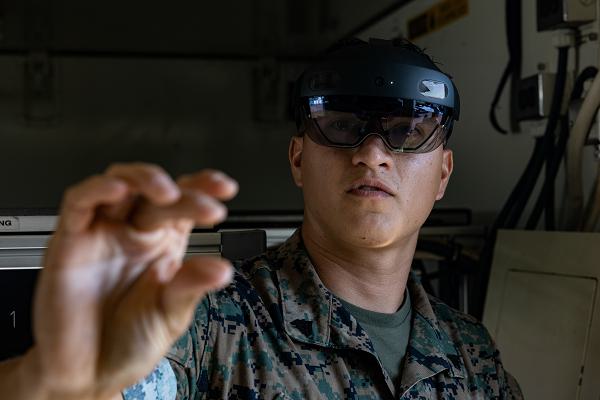
Marine Corps Air Station Cherry Point, North Carolina. (August 26, 2024): When we see youngsters playing video games wearing oversized goggles, we think Nintendo, Play Station… the U.S. Air Force? That’s right. The technology that created today’s popular “virtual reality” games originated with the Air Force Research Laboratory, or AFRL. In this photo by Lance Corporal Orlanys Diaz Figueroa, Corporal Vradley Cerna, a digital wideband systems maintainer with Marine Wing Communications Squadron 28, tests tele-maintenance capabilities at the Marine Depot Maintenance Command. The military is experimenting with augmented reality technology as part of its effort to modernize its maintenance capabilities.
Augmented reality (AR) is different from “virtual” reality in that it overlays digital information onto real world objects which allows users to interact with both the real and virtual elements simultaneously. AR devices, such as smartphones, tablets, smart glasses, and headsets use cameras and sensors to enrich a user's perception of reality.
AR technology is vital to diagnosing tiny imperfections in aircraft parts, for example, which are damaged due to the many “crash landings” fighters make landing on carriers. The stress of these landings creates fatigue cracks that can develop over the lifecycle of a metal airframe, especially when their life is extended beyond the original design life. These cracks, if not detected early, can grow into a serious threat of a catastrophic outcome for pilots.
To reveal these dangerous metal flaws, AR provides an interactive experience that enhances the real-world using software that overlays digital content onto real-life environments and objects. AR incorporates three basic features: a combination of real and virtual worlds, real-time interaction, and accurate 3D registration of virtual and real objects. Hence the term “augmented reality” which alters one's ongoing perception of a real-world environment versus virtual reality that completely replaces the user's real-world environment with a simulated one.
The earliest functional AR system that provided immersive mixed reality experiences for users was invented by the U.S. Air Force's Armstrong Laboratory in 1992. It was there that scientists developed a head-mounted display that places images of both the physical world and virtual objects over the user's field of view. Today, the Air Force Research Laboratory has become the primary scientific research and development center leading the discovery, development, and integration of affordable warfighting technologies.


